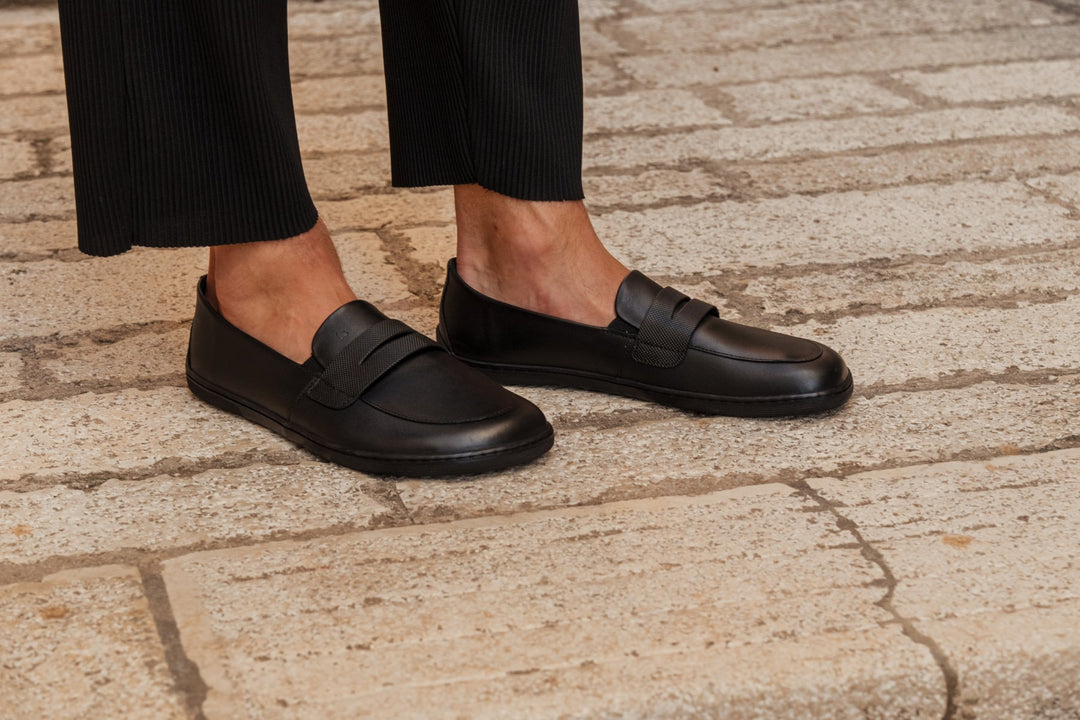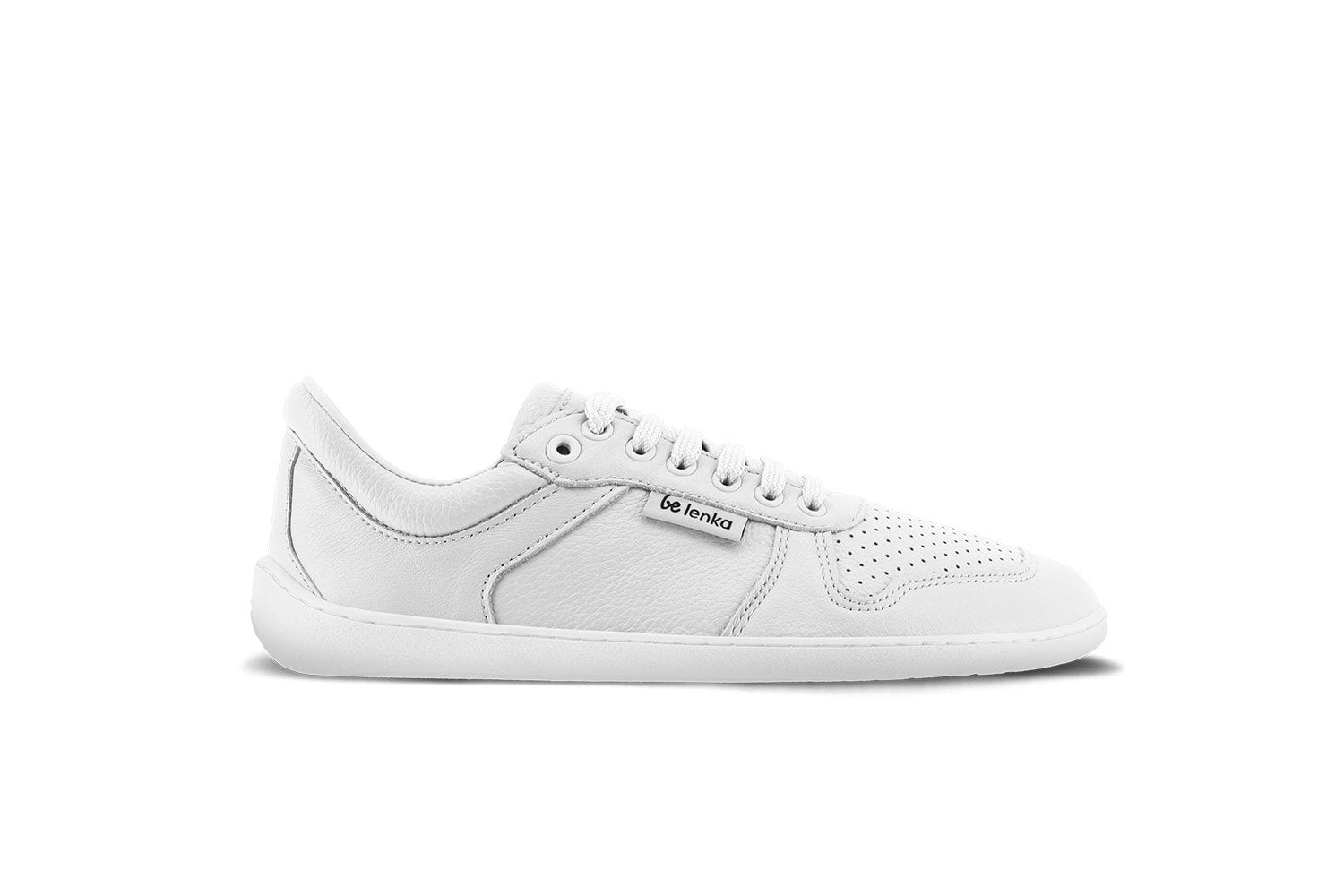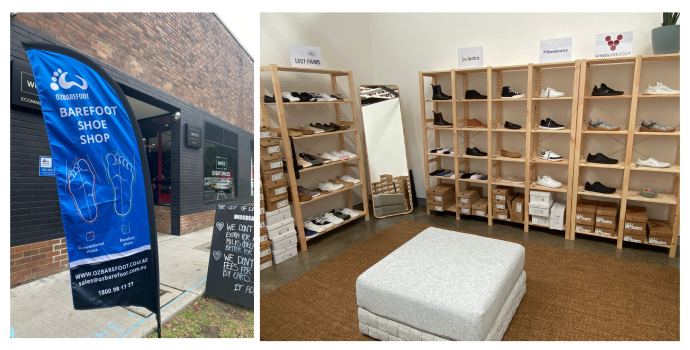Have you ever noticed how fashion trends tend to become more extreme over time? For example, early versions of jeans used to all have a fairly consistent fit, but now you can easily find styles that are as tight as leggings or as loose as sweatpants and anything in between. This phenomenon holds true for footwear as well.
Singling out sneakers for a moment; these used to be a fairly homogeneous type of shoe. Now, you'll see many different versions of sneakers with highly exaggerated features popular within mainstream audiences. One common iteration of this is sneakers with a highly elevated heel.
Unfortunately, elevated heels are insidiously becoming one of the worst shoe trends for foot health, and few people are talking about it outside of perhaps podiatrists and barefoot shoe enthusiasts. This problem doesn't just exist within sneakers either. Sadly it extends over practically every category of shoe styles.
Here's why you should care about it, and why you should consider replacing your conventional shoes with raised heels with zero drop shoes instead.
What Are Zero Drop Shoes?
Zero drop shoes are simply shoes that have the heel and the forefoot portions of the inner sole at an equal height. This means there is no comparative elevation in the heel, and that the foot is in a flat position while wearing them.
All barefoot shoes fit into this classification of zero drop shoes since it's one of the key design elements that sets them apart from regular shoes.
Read more: Health benefits of wearing barefoot shoes
However, zero drop shoes are actually a broad category of shoes that includes other shoe varieties too.
Many flats, loafers, sandals, as well as some boots and even a few types of sneakers such as the classic converse all technically fall under the umbrella of zero drop shoes as well—though we wouldn't personally recommend all of these for other reasons.
Despite the many available options for zero drop shoes, most people (and not just women) still tend to opt for shoes with raised heels. There are a few typical reasons why this is, but the cons clearly outweigh the cons, and most people don't even realise the price they're paying with their foot health.
Why Are Raised Heels So Common?
To put it bluntly, the main reason raised heels are so common is often related to vanity. High heeled shoes help women look more feminine by exaggerating the curve in their lumbar spine.
It alters their posture so their curves look more prominent, and their legs look elongated. This may be the desired look for special occasions, but wearing shoes with heels daily takes a serious toll on the feet.
Men's reasons for wearing heeled shoes often aren't so different. Most men are happy to take any bit of extra height they can get, and wearing shoes with a slightly elevated heel is the easiest way to do this.
Because of this, you'll see raised heels on dress shoes, winter boots, running shoes, sandals and quite frankly many other places they don't belong.
Popular shoe designers have put fashion before function, and they'll continue to do so unless the demand from the public changes. Looking good and being confident is important, but it shouldn't have to come at the cost of damaging your health.

Did you know: high heeled shoes were originally invented for men? One of the first pair of heels come from 10th century Persion where they were designed to add height and make riding on horseback in stirrups easier for wealthy men.
The Benefits of Zero Drop Shoes
Zero drop shoes are one simple swap that could completely transform not just your foot health, but also your posture, back pain and even knee pain. These are the benefits you can reap and the pitfalls of heeled shoes you'll want to avoid.
1) Reduces Pressure on Senstive Tendons and Ligamnets
Perhaps the most immediate benefit you'll notice from wearing zero drop shoes is the reduced pressure on the forefoot. When wearing heeled shoes, the foot is in plantarflexion where the ankle joint is partially extended. This means your weight will be shifted further forward to put greater pressure on the joints of the toes.
This intricate area isn't designed to endure such pressure since it puts excess stress on the tendons and ligaments in the area. This can easily lead to short term pain (ask any woman how her feet feel after a night in heels) as well as chronic issues like stress fractures, stiffness, and even tendon or ligament damage (1).
2) Better Ankle Stability
Another drawback of heeled shoes is how they alter your center of gravity, reduce connection to the ground, and can therefore throw off balance and ankle stability. This is particularly noteworthy for athletes who need to maximize their stability as a base for power, but it also applies to everyday individuals.
Weight lifters know this and often make a point to opt for flat-footed shoes while lifting heavy weights at the gym. This improves stability to reduce risk of injury and allows for optimal biomechanics.

When instead your foot is in an unnatural position all day (plantarflexion), small muscles will have to attempt to stabilize your ankle, and they can easily become fatigued or even injured (2). This could leave you more vunerable to accidents like sprained or rolled ankles.
3) Lengthens The Calf Muscle
Another important feature of zero drop shoes is how they affect the calf muscle. This muscle in behind the shin bones is responsible for moving the ankle joint into extension, and it's extremely important for running, jumping, and even walking.
Unfortunately, shoes with raised heels shorten the calf muscle, and when it's held in this position consistently it can lead to a reduced range of movement that affects both athletic and practical abilities. Tight calf muscles impair your ability to generate power in your stride as well as your ability to bend at the ankle for movements such as squatting (3).
On top of this, shortened calf muscles provide less natural spring in your step to protect your knees, so the force of walking or running will cause additional wear and tear on this delicate joint.
4) Improves Posture
This point truly shows how footwear can effect not only the feet, but the health of your whole body. Raised heels cause your center of gravity to shift forward which usually results in an overly arched lower back.
This is a problem because it causes tightness in the hip flexors, excess pressure and pain in the low back, and even more issues which can travel up the length of the spine (4). The spine extends from the back of your neck down to your tailbone, and having proper posture is one of the best things you can do to protect this incredibly essential and finicky body part.
5) Can Help Avoid Plantar Facietis and Bone Spurs
This last benefit of zero drop shoes may not affect everyone, but it's importance for people it does can't be overstated. Plantar fasciitis is an issue where a thick band of connective tissue called fascia becomes damaged and inflamed. It results in intense foot pain on the bottoms of the feet and into the heel.
One way the plantar facia can become damaged is from the excess strain on it from wearing high heeled shoes (5). Plantar facilities can also come alongside a related issue of bone spurs in the heel where a boney overgrowth occurs under heel bone, usually causing pain or discomfort.
Can Everyone Wear Zero Drop Shoes?
Though zero drop shoes clearly have many benefits, they may not be suitable for everyone at all times. Sometimes foot issues are too progressed to be able to accommodate this style of footwear, so they earlier you can make the switch the better.
Those who already have plantar fasciitis or bone spurs for example may not do well with flat shoes since their heel will be quite sensitive. They may need arch support, cushioning and a slightly raised heel while they're recovering.
Even with an absence of foot issues, it's best to start slow by gradually building up the length and frequency you wear zero drop shoes to give your feet time to acclimatize.
If in doubt, always check in with a podiatrist, a physiotherapist, a sports medicine physician, or another expert to see if this style of shoe can work for you.
Further reading: Are Barefoot Shoes Good for Everyday Use?
Zero Drop Shoe Recommendations
There are plenty of zero drop shoe options on the market, but the easiest way to ensure they'll optimal for foot health is to search for barefoot style shoes.
Several brands like Be Lenka, Barebarics and Xero Shoes make stylish everyday options that are indistinguishable from non-barefoot shoe styles. Groundies is another great option for women in particular who are seeking stylish sandal or flats with zero drop heels.
Conclusion
Overall, there's no one perfect shoe that works well for everyone, but wearing zero drop shoes can benefit most people and potentially prevent a whole host of bodily issues down the line.
Always stay in tune with your body to determine what footwear works best for you and don't hesitate to experiment with breaking free from the status quo. Your feet will thank you.
Article Sources
- Maxwell S Barnish. (2016). High-heeled shoes and musculoskeletal injuries: a narrative systematic review. British Medical Journal.
- Gabriel Moisan (2020). The influence of footwear on walking biomechanics in individuals with chronic ankle instability. The Public Library of Science.
- Rebecca L. Krupenevich. (2022). Reduced Achilles Tendon Stiffness Disrupts Calf Muscle Neuromechanics in Elderly Gait. Gerontology.
- Carolyn J. Sparrey. (2014). Etiology of lumbar lordosis and its pathophysiology: a review of the evolution of lumbar lordosis, and the mechanics and biology of lumbar degeneration. The Journal of Neurosurgery.
- Yu Jia. (2016). The influence of high-heeled shoes on strain and tension force of the anterior talofibular ligament and plantar fascia during balanced standing and walking. Medical Engineering and Physics.













